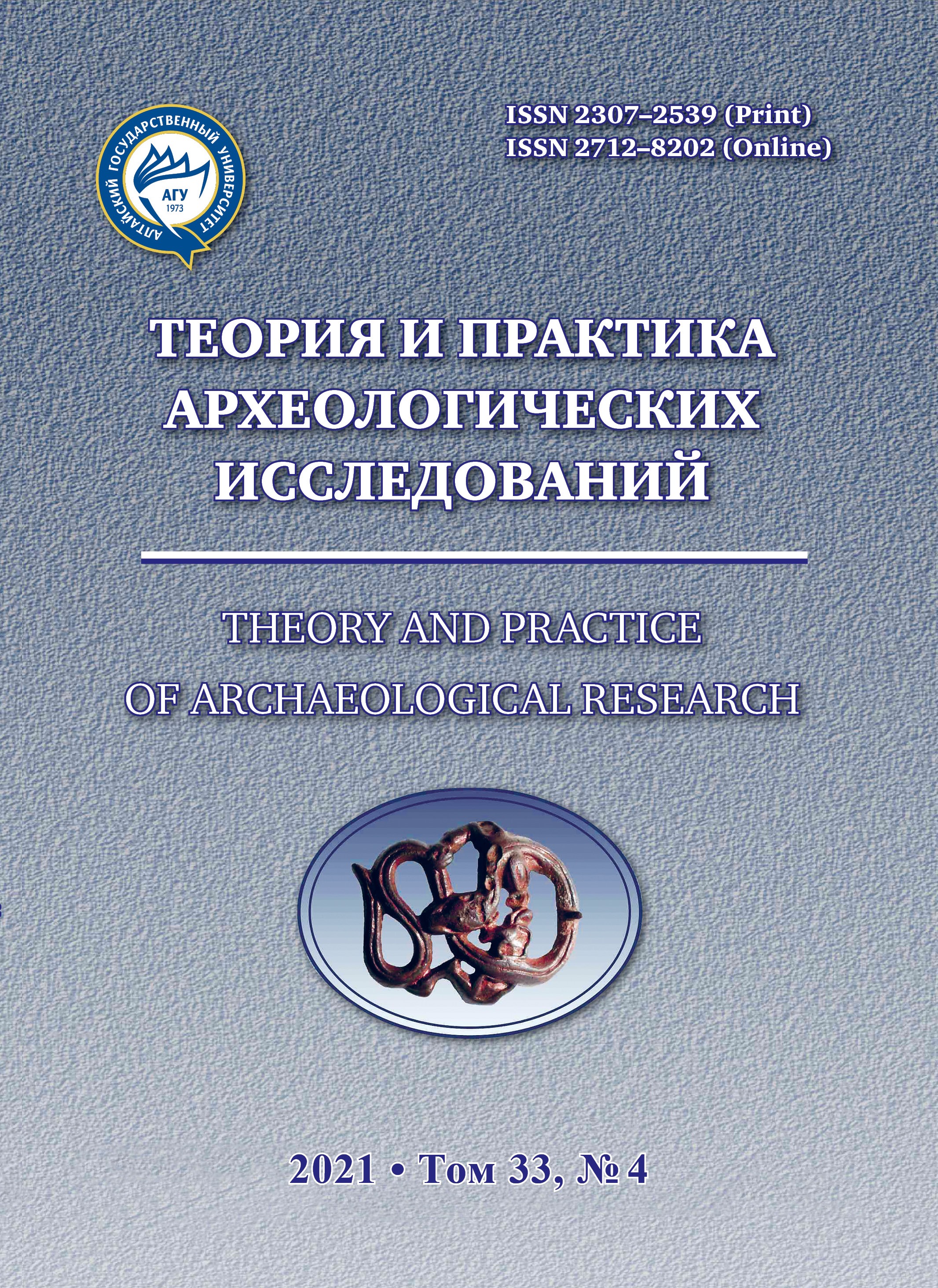Miniature Clay Products of the Imenkovo Culture in the 6th –7th Centuries AD
Abstract
The article deals with miniature clay products of the Imenkovo culture. They are often mentioned in publications of finds both from the Imenkovo hillforts and from the settlements. At the same time, they are not found in the Imenkovo burial grounds. The research was based on a representative collection of miniature items from the Tetyushy-II hillfort in the Tetyushy district of Tatarstan. In addition, published materials from excavations of other Imenkovo settlements both in the Republic of Tatarstan and in the neighboring regions — Ulyanovsk and Samara were used. The author studied 124 miniature objects. They were grouped into four divisions. The first one includes geometrical objects (balls, cones, etc.), accounting for 22.5% of all finds. The second includes jewelry (9.8%). The most numerous (42.7%) is the third section — household items. Most of them are miniature vessels. The last section includes miniature images of animals (25%). All products are made of pure clay. They are well burnt. Moreover, almost all of them are either broken or have the loss of individual parts. Since the crafts were very durable, it is obvious that they were smashed on purpose. By their functional purpose, they were: 1) cult objects related to production activities (miniature figurines of animals); 2) magic crafts; 3) elements of ritual procedures; 4) household items (for example, drinking bowls); 5) shells for weapons (sling). In the latter case, natural nodules were used for the same purpose. The origin of most of the miniature vessels is associated with the Volga region. In the decorations and a number of types of miniature vessels, the connection of these artifacts with the antiquities of the Dyakovo archaeological culture can be traced. There are analogies in the antiquities of the Kiev culture. Miniature vessels with a round bottom are associated with cultures of the 1st millennium AD in Southern Cis-Urals. Some of the items of this complex were formed under the influence of the Sarmatian culture. All considered items are dated to the 6th–7th centuries AD. Thus, for the first time, the systematization of miniature items of the Imenkovo culture, their attribution and dating has been carried out.
Downloads
Metrics
No metrics found.
References
Bagautdinov R.S., Nikitina A.V. Research of the Osh-Pando-Ner settlement on Samarskaya Luka in 1994 (based on materials from the excavations by G.I. Matveeva). Srednevekov’e. Velikoe pereselenie narodov (po materialam arheologicheskih pamyatnikov Samarskoj oblasti = Medieval. The Great Migration of Peoples (based on materials from archaeological sites of the Samara region). Samara : Samarskoe arhivnoe obshchestvo, 2013. Pp. 164–186. (In Russ.)
Bogachev A.V., Vyazov L.A., Gasilin A.V., Myshkin V.N., Seryh D.V. Karmaly hillfort. Srednevekov’e. Velikoe pereselenie narodov (po materialam arheologicheskih pamyatnikov Samarskoj oblasti = Medieval. The Great Migration of Peoples (based on materials from archaeological sites of the Samara region). Samara: Samarskoe arhivnoe obshchestvo, 2013. Pp. 119–163. (In Russ.)
Burov G.M. Imenkovo Culture in the Ulyanovsk Volga Region. Drevnosti Srednego Povolzh’ya = Drevnosti Srednego Povolzh’ya Antiquities of the Middle Volga region. Kujbyshev: Izd-vo un-ta, 1985. Pp. 111–130. (In Russ.)
Vyazov L.A., Semykin Yu.A. The Novaya Bedenga Settlement: the Era of the Great Migration of Peoples in the Ulyanovsk Pre-Volga Region. Ul’yanovsk : NII istorii i kul’tury, 2016. 227 p. (In Russ.)
Dubynin A.F. Shcherbinskoe Hillfort. D’yakovskaya kul’tura = Dyakovskaya Culture. М.: Nauka, 1974. Pp. 198–281. (In Russ.)
Kazakov E.P. Comintern II Burial Ground in the System of Antiquities of the Era of the Turkic Kaganates. Kul’tury Evrazijskih stepej vtoroj poloviny I tys. n.e. (voprosy hronologii) = Cultures of the Eurasian Steppes of the Second Half of the 1st Millennium AD. (questions of chronology). Samara : SOIKM, 1998. Pp. 97–150. (In Russ.)
Kazakov E.P., Rafikova Z.S. Essays on the Ancient History of the Eastern Trans-Kama region. Seriya: Iz istorii Al’met’evskogo regiona. Vyp. II = Series: From the History of the Almetyevsk Region. Issue II Al’met’evsk : Fond Al’met’evskaya enciklopediya, 1999. 120 p.). (In Russ.)
Klyuchnikova R.M., Matveeva G.I. Settlement Osh-Pando-Ner. Drevnosti Srednego Povolzh’ya = Antiquities of the Middle Volga. Kujbyshev : Izd-vo un-ta, 1985. Pp. 131–155. (In Russ.)
Krasnov Yu.A. Bezvodninsky Burial Ground (To the history of the Gorky Volga region in the early Middle Ages). M. : Nauka, 1980. 224 p. (In Russ.)
Krenke N.A. Dyakovo Hillfort: the Culture of the Population of the Moskva River Basin in the 1st Millennium BC — I Millennium AD. M. : IA RAN, 2011. 548 p. (In Russ.)
Mazhitov N.A., Sungatov F.A., Sultanova A.N., Ismagilov R.B., Bakhshieva I.R. The Ufa II Settlement. Excavation Materials of 2008. Vol. III. Ufa : GUP RB UPK, 2009. 368 p.
Matveeva G.I. Residential and Outbuildings of the Staro-Maini hillfort. Archaeological research in the Volga region. Samara : Izd-vo un-ta, 1993. Pp. 156–183. (In Russ.)
Matveeva G.I. The Middle Volga region in the 4th–7th centuries: Imenkovskaya culture. Tutorial. Samara : Samarskij un-t, 2003. 160 p. (In Russ.)
Matveeva G.I., Bogachev A.V., Nabokov A.V. Perevolokskoe hillfort. 40 let Srednevolzhskoj arheologicheskoj ekspedicii. Seriya: Kraevedcheskie zapiski SOIKM. Vyp. XV = 40 Years of the Middle Volga Archaeological Expedition. Series: Local History Notes SOIKM. Issue XV. Samara : SOIKM, 2010. Pp. 231–242. (In Russ.)
Myshkin V.N. The Burial Ground of the Early Middle Ages near the Village Podgory on Samarskaya Luka. Srednevekov’e. Velikoe pereselenie narodov (po materialam arheologicheskih pamyatnikov Samarskoj oblasti) = Medieval. The Great Migration of Peoples (based on materials from archaeological sites of the Samara region). Samara : Samarskoe arhivnoe obshchestvo, 2013. Pp. 73–118. (In Russ.)
The Sites of Kiev Culture in the Forest-Steppe Zone of Russia (the 3rd - early 5th Century AD). M. : IA RAN, 2007. 318 p. (Series: Early Slavic world. Issue 10). (In Russ.)
Pereskokov M.L. Perm Urals in the End of the Early Iron Age. Perm’ : PGNIU, 2018. 320 p. (In Russ.)
Pugachenkova G.A. About One Group of Stucco Terracotta Figurines of Tokharistan. Novoe v sovetskoj arheologii = New in Soviet Archaeology. M. : Nauka, 1965. Pp. 48–252 (Series: Materials and research on archeology of the USSR, No. 130). (In Russ.)
Rafikova Z.S. On the Issue of the Cultural and Genetic Origins of the Bearers of the Imenkov Culture (based on the materials of the I Polyankino settlement). Issledovaniya po srednevekovoj arheologii Evrazii = Research on Medieval Archaeology of Eurasia. Kazan’ : RIC, 2012. Pp. 248–265. (In Russ.)
Rudenko K.A. The Malopolyanskoe V Settlement. Cultures of the Eurasian Steppes of the Second Half of the 1st Millennium AD. (Questions of Chronology). Samara : SOIKM, 1998. Pp. 185–197. (In Russ.)
Rudenko K.A. Small Clay Plastic of the Imenkov Culture. Kamennaya skul’ptura i melkaya plastika drevnih i srednevekovyh narodov Evrazii = Stone Sculpture and Small Plastic of the Ancient and Medieval Peoples of Eurasia. Barnaul : Azbuka, 2007. Pp. 64–
(Series: Proceedings of the Siberian Association of Researchers of Primitive Art. Issue 3). (In Russ.)
Rudenko K.A. Tetyushskoe II Hillfort in Tatarstan. Kazan’ : Zaman, 2010. 152 p. (In Russ.)
Rudenko K.A. Ancient Tetyushy. Archaeological Research. Kazan’ : Zaman, 2011. 144 p. (In Russ.)
Rudenko K.A. About Magic and Cult Objects of Imenkov Culture: to the Question of the Worldview of the Population of the Kazan Volga Region in the Era of the Great Migration of Peoples. Mirovozzrenie naseleniya YUzhnoj Sibiri i central’noj Azii v istoricheskoj retrospektive = Worldview of the Population of South Siberia and Central Asia in a Historical Retrospective. Issue VII. Barnaul : Izd-vo Alt. un-ta, 2014. Pp. 106–128. (In Russ.)
Rudenko K.A. Stratigraphy of the Settlements of the Imenkovo Culture of the Kazan Volga Region. Teoriia i praktika arheologicheskih issledovanij = Theory and Practice of Archaeological Research. 2018;2(22):80–98. (In Russ.)
Starostin P.N. Sites of the Imenkovo Culture. M. : Nauka, 1967. 100 p. (Series: SAI. Issue D1-32). (In Russ.)
Starostin P.N.The Maklasheevka II Hillfort of Imenkovo Culture. Trudy Kamskoj arheologicheskoj ekspedicii. Vyp. IV = Proceedings of the Kama Archaeological Expedition. Issue IV. Perm’ : PGU, 1968. Pp. 221–229 (Scientific Notes of Perm State University, №191). (In Russ.)
Starostin P.N. Work on the Trinity-Uraisky I Hillfort in 1973. In: Volga-Kamya Antiquities. Kazan’ : IYaLI KFAN, 1977. Pp. 31–41. (In Russ.)
Stashenkov D.A. The Settled Population of the Samara Forest-Steppe Volga Region in the 1st–5th Centuries. AD. M. : SOIKM; IA RAN, 2005. 150 p. (Series: Early Slavic World. Issue 7). (In Russ.)
Stashenkov D.A. About the Early Date of the Imenkovo Culture. 40 let Srednevolzhskoj arheologicheskoj ekspedicii = 40 Years of the Middle Volga Archaeological Expedition. Samara: SOIKM, 2010. Pp. 111–125 (Series: Local history Notes SOIKM. Issue XV). (In Russ.)
Stashenkov D.A. The Karlinskoe I Settlement (preliminary publication). Problems of Interaction of the Population of Eastern Europe in the Era of the Great Nations Migration. M.: IA RAN, 2014. Pp. 436–466. (Series: Early Slavic world. Issue 15). (In Russ.)
Stepanov P.D. Osh Pando. Saransk : Mordovskoe kn. izd-vo, 1967. 212 p. (In Russ.)
Theory and Practice of Archaeological Research is a golden publisher, as we allow self-archiving, but most importantly we are fully transparent about your rights.
Authors may present and discuss their findings ahead of publication: at biological or scientific conferences, on preprint servers, in public databases, and in blogs, wikis, tweets, and other informal communication channels.
Theory and Practice of Archaeological Research allows authors to deposit manuscripts (currently under review or those for intended submission to ABS) in non-commercial, pre-print servers such as ArXiv.
Authors who publish with this journal agree to the following terms:
- Authors retain copyright and grant the journal right of first publication with the work simultaneously licensed under a Creative Commons Attribution License (CC BY 4.0) that allows others to share the work with an acknowledgement of the work's authorship and initial publication in this journal.
- Authors are able to enter into separate, additional contractual arrangements for the non-exclusive distribution of the journal's published version of the work (e.g., post it to an institutional repository or publish it in a book), with an acknowledgement of its initial publication in this journal.
- Authors are permitted and encouraged to post their work online (e.g., in institutional repositories or on their website) prior to and during the submission process, as it can lead to productive exchanges, as well as earlier and greater citation of published work (See The Effect of Open Access).








2.jpg)




